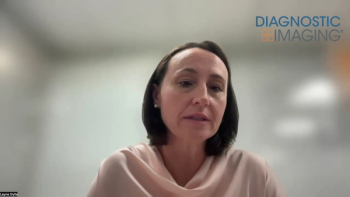
Coronary MSCT cuts rate of negative cardiac cath
A small outcomes study presented at the RSNA meeting has shown that multislice cardiac CT can be applied in specific ways to eliminate unnecessary cardiac catheterizations for coronary artery disease.
A small outcomes study presented at the RSNA meeting has shown that multislice cardiac CT can be applied in specific ways to eliminate unnecessary cardiac catheterizations for coronary artery disease.
The trial involved 133 stable patients who had previously undergone an equivocal nuclear myocardial perfusion or stress echocardiography study. It found that an MSCT coronary artery exam can reliably identify candidates for cardiac catheterization.
Dr. Thomas Rosamond, a cardiologist with Mid-America Cardiology at Kansas University Hospital in Kansas City, presented the findings. He conducted the trial with Dr. Louis Wetzel, a professor of radiology at Kansas University.
Results were based on coronary artery angiography performed on a 16-slice scanner for the first 30 patients before the outpatient department shifted to 64-slice CT imaging for the remaining 103 cases. In combination, the machines enabled radiologists and cardiologists interpreting the exams to recommend against coronary catheterization for all but 18 patients, Rosamond said.
Significant coronary artery disease (greater than or equal to 50% stenosis) was present in all cases referred for cardiac cath. Seven patients underwent angioplasty, four underwent coronary bypass surgery, and seven were treated medically with drugs or behavioral risk factor modification. No adverse coronary events were reported for the 86% of patients who were not catheterized in a 20-week follow-up period after MSCTA evaluation, Rosamond said.
The average age of the patients was 55 years, ranging from 18 to 85 years. Forty-four percent were female. The mean calcium score was 325 and ranged from 0 to 3500. All patients had stable disease and were scanned on a routine outpatient basis after a borderline nuclear stress exam or stress echocardiography.
Placing the results in context, the ability of cardiac CT to assure greater than 95% specificity for patients referred for cardiac catheterization contrasts with the national experience as compiled by the American College of Cardiology National Registry. That measure found that 35% of patients undergoing invasive coronary angiography are normal or nearly normal as defined by less than 50% stenosis in any single vessel, Rosamond said. Previous experience at the University of Kansas hospital has been consistent with that trend.
The financial implications of performing MSCTA to eliminate unnecessary catheterization are considerable. The out-of-pocket expense for 64-slice CTA in Kansas City is about $1000, or 10 times less than the typical $10,000 cost of cardiac catheterization, he said.
Larger multicenter trials are needed to confirm the results before physicians begin to add up the savings.
"The bottom line is that it is feasible to use this technology as a gatekeeper for the cath lab," Rosamond said.
Newsletter
Stay at the forefront of radiology with the Diagnostic Imaging newsletter, delivering the latest news, clinical insights, and imaging advancements for today’s radiologists.



























